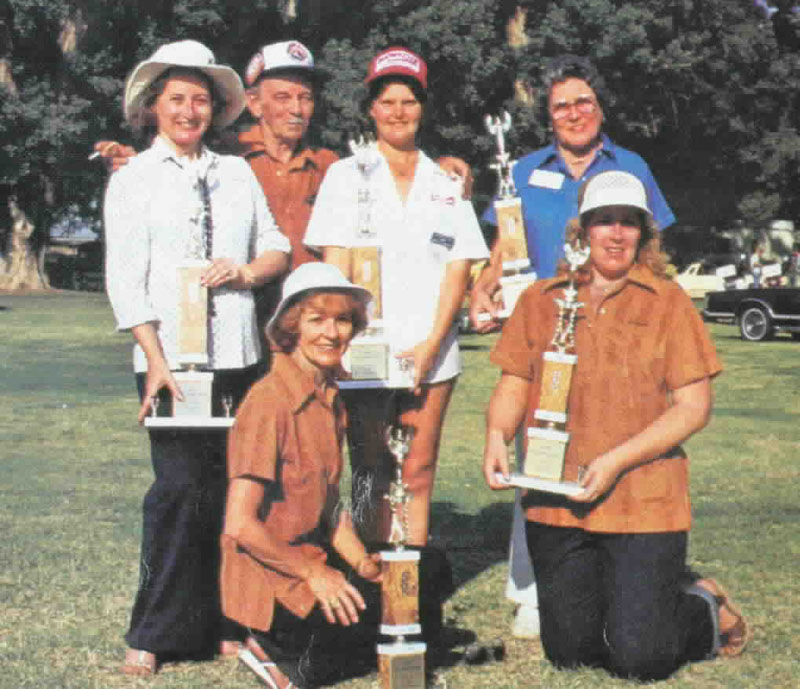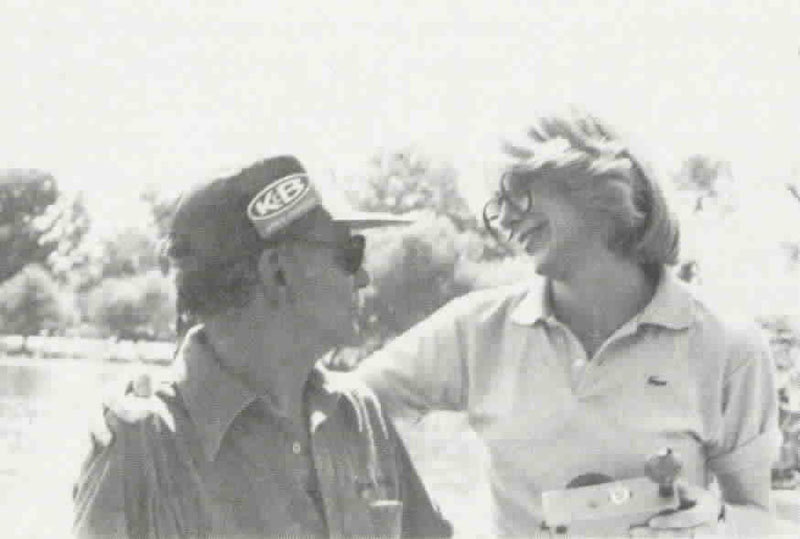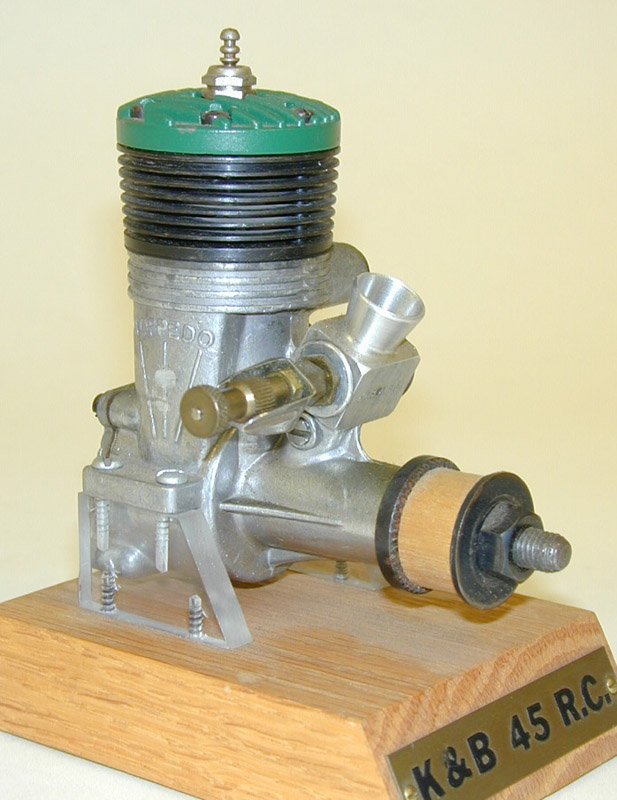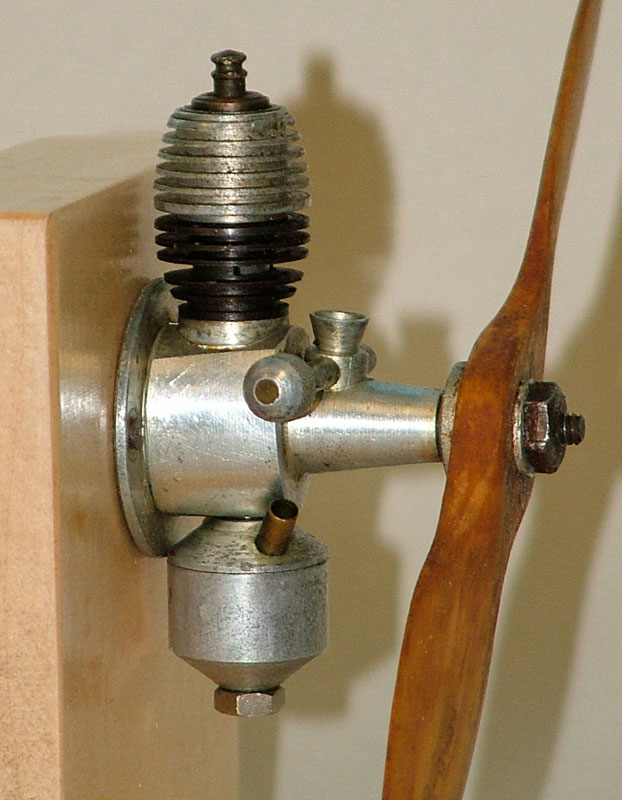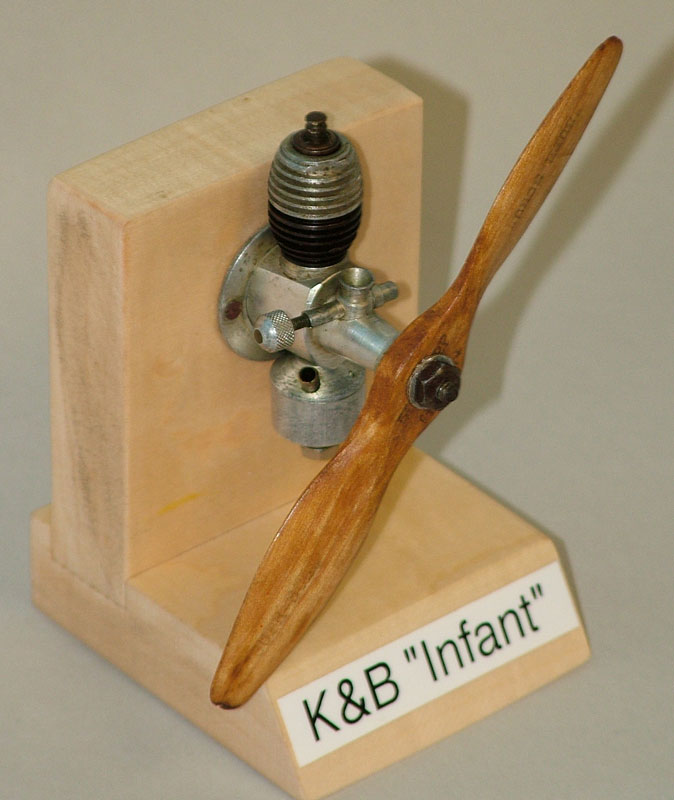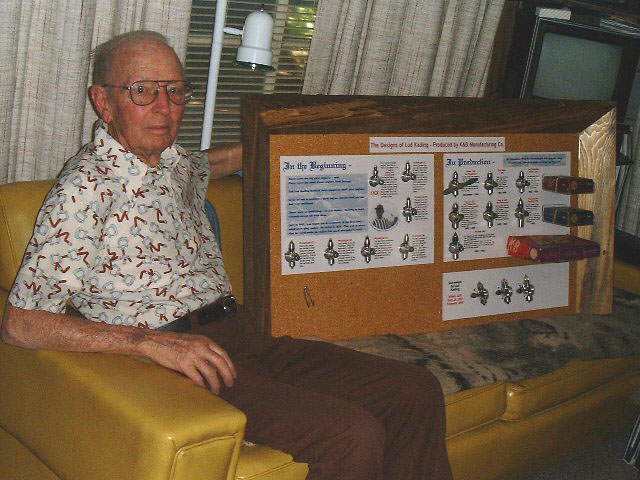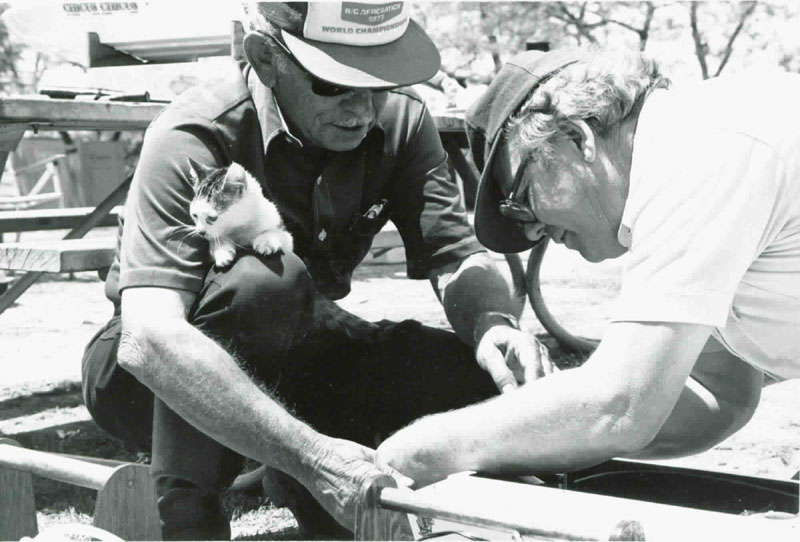September 14, 1913—November 2, 2004
One of the Innovative Manufacturers of the K&B Engine Series
John Brodbeck (left) with a young Joe Martin, holding one of the trophies that John had generously donated for an early RC flying contest. The contest was organized by Joe and Jerry Nelson in Turlock, CA. Joe managed to take first place in the contest. As he says, “It helps when you get to write the rules.”
Foreword from the Late Joe Martin
I first met John Brodbeck at his manufacturing plant in Los Angeles. Jerry Nelson and I were traveling in Southern California to promote a new radio control racing event we were trying to start. On the spur of the moment, we decided to stop at K&B to see if John thought our idea was worth pursuing. I was somewhat embarrassed to show up without an appointment, but Jerry was far more of a promoter than I was, and not having an appointment didn’t bother him.
John met with us and immediately put me at ease. Jerry did most of the talking, and explained to John what we were trying to do. Before Jerry was through with his spiel, and before we could even ask, John said, “What a great idea, I’ll buy the trophies.” He not only bought the trophies, but he and his brother flew up to our contest in Turloc, 100 miles east of San Francisco, and helped make our first contest a success.
He wasn’t there to sell his particular brand of engines; he was there to have fun participating in the hobby he loved. Like many successful people, John’s success was a byproduct of participating in the hobby he loved. With the help of John and his son, John Jr., our contest became a popular worldwide event.
Those who know him remember best his helpfulness. Jay Crews, former assistant editor of RC Modeler magazine, had this to say: “John was a great friend as I was growing up in the early 1980’s. He got me into model boating, and was an incredible role model. He is without a doubt one of the kindest most generous people I have ever met.” We are glad to be able to honor John Brodbeck’s contributions here. —Joe Martin
Much of the information below was gathered with the help of a video produced by the Academy of Model Aeronautics in 1986. In that video, John Brodbeck was interviewed by host John Worth. Interviews with Bill Brown and Irv Ohlsson were also included.
John Brodbeck and the Story of K&B Engines
John first started flying free-flight models in 1936 using a Brown Junior engine. He also turned to Baby Cyclone and Hurleman engines for some of his early planes. He wasn’t happy with the performance of most of the early engines though, and like many early flyers, he did some fine-tuning and modification of his own. He liked the magnesium-cased Torpedo and Bullet engines of the time; however, he found that the sleeve was too loose to allow it to produce its full potential power. Fuel would go around the sleeve and out the exhaust. So John made his own sleeves and connecting rods, which allowed the engine to perform better on his models. Working on these engines had John considering making his own engine, but World War II put a temporary hold on his plans.
A photo from the cover of the August 1980 issue of R/C Modeler magazine. In 1980, K&B sponsored a Lady Boaters Regatta (From the left: Pat Crews, John Brodbeck, Ricki Stewart, Pat Pottol, Diana Semler and Dot Prather).
John Teams up With Lud Kading to Form K&B
During the war, John was working at California Machining in Los Angeles, and had eventually climbed his way up to general manager. He had met Lud Kading in 1932, during a three-car trade, and eventually the pair began flying model planes together around 1936. John was in need of a good man to run the tool room at California Machining, so he contacted Lud who was working in the wood shop at Fluor Corp. Lud decided to leave Fluor, and came to work at California Machining for the duration of the war. In April of 1944, it became apparent that wartime production was winding down, and both John and Lud were about to lose their jobs.
At that time John still had dreams of building engines of his own, but raw materials were in short supply. Ultimately, John and Lud decided to start their own business taking on whatever machining jobs they could find. They did this until they could get the material and capital needed to start building their own engines. In July of 1944, they started K&B Manufacturing with a couple of old Logan lathes and some drill presses. They set up shop in Lud’s two-car garage, because John’s garage was too small. The pair secured some work making cannon yokes for Lockheed, and they eventually found their way into making precision machined parts for the Manhattan Project—the making of the first atomic bomb.
Finally, they had enough working capital to start making the engines of their dreams. John and Lud designed the .29 engine based on John’s improvements to the old Torpedo engine. They made a run of engines which were produced using all screw machine parts, no castings. Then, Nathan Smith, a friend who manufactured coils, told them that Bill Atwood owned the rights to the old Torpedo and Bullet engines. Bill had purchased the inventory from the screw machine shop that had been producing them. However, Bill was no longer interested in making the engines, so John was able to purchase the name and about $200 worth of old inventory. The Torpedo name already had pre-war recognition, so in June of 1946 they built their first engine. It hit the hobby shops in 1947.*
*Apparently Mr. Atwood had also sold the rights to the Torpedo name to another company, who introduced an engine called the “Torpedo Special.” This caused some confusion in the marketplace.
After acquiring the rights, John and Lud began work on a tiny .010 cubic inch engine. Unfortunately, after about six months of trial they still couldn’t get it to run. So they decided to double the displacement to .020, but still had trouble because the smallest existing glow plug was still very large compared to their cylinder size. Then, one night John came up with the idea for his “capsule plug,” which was a one-piece combustion chamber and plug. They got it to work. At the time, no kits or propellers were available for an engine as small as theirs. John and Lud also feared that if they went to a prop manufacturer to ask for a 4-3/4” prop, the manufacturers might let the cat out of the bag. So the two came up with a die for a bent aluminum prop sized to their own engine, and they made their own props in order to catch the market by surprise.
At this time, working capital was still tight, but they decided to make a run of 10,000 “Infant Torpedo” engines. They announced the product after the first 3,500 engines were assembled, and John said that one week later they had orders for 280,000 engines. So the pair spent the next year feverishly trying to meet demand for the engine, which they would never catch up to. John and Lud also introduced a .035 and .049 engine, both of which eventually became more popular than the tiny .020. No one seemed to agree on an exact figure of how many engines were actually sold, but for a long time it was, “every one they could make,” which is every manufacturers dream. Like Irv Ohlsson and some of the other pioneer engine builders, John and Lud were fortunate to be in the hobby at a time of tremendous growth, and they had the necessary skills and talents to take advantage of it.
The K&B “Infant Torpedo” .020 engine. The original design as an .010” wouldn’t run, so displacement was increased to .020″. One week after introduction they had orders for 280,000 engines. Eventually .035″ and .049″ versions of the Infant were offered. (Donated by Donald Holcomb)
Eventually, Lud Kading left the company in 1953 to pursue other interests. John and Lud remained lifelong friends, and John never felt the need to remove the “K” from the K&B name. After 1953, the company was run by John alone, until he ultimately turned the reigns over to his son.
During this time, K&B grew through several manufacturing facilities in Los Angeles, Compton, and eventually Downey in 1961. K&B Engines remained a success story in the model engine field. This was mainly because their engines always took advantage of the latest technology and quality control methods. In the mid-1980’s, they began using CNC tools to improve quality and consistency even further. John’s son, John Brodbeck “Junior,” would eventually take over responsibility for running the company. It was later sold to Randy and Anching Linsalato, whose RJL Enterprises continues to market the K&B engine line today. This makes K&B the longest continuous manufacturer of model engines in the USA.
A photo of Lud Kading from 2001 (age 87) shows him with a display of some of the “Infant” K&B engines. The display was built by Tim Dannels of The Engine Collector’s Journal, who also contributed the photo.
John remarked that the company had survived three major recessions, and many times he didn’t know where the next payroll check was coming from. However, their conservative approach to maintaining working capital always got K&B through tough times. John W. Brodbeck and Lud Kading were among a lucky few who were able to turn their youthful love for model flying into a successful career in the model engine business.
We regret to inform that John passed away on November 2, 2004. Lud also passed away on February 25, 2011. Their legacies live on through K&B Engines, and the countless hobbyists whose goals were achieved thanks to their dedication to the craft.
John was voted into the NAMBA (North American Model Boating Association) International Hall of Fame in 1982, and was inducted into the AMA (Academy of Model Aeronautics) Hall of Fame in 1977. For more information about John, see his biography from the AMA.
The AMA also wrote a biography for Lud Kading.
John Brodbeck (left) and Al Prather (of Prather Products), circa 1983. Joe Martin noted that Al had a business souping up Super Tigre engines around the same time that Joe and Jerry had started their racing event. When this picture was taken, Super Tigre engines were becoming the predominant engine, and were cutting into K&B’s business. Things like this didn’t keep John from being good friends with his competitors. He truly was “one of a kind.” (John and Al died within 8 days of one another in late 2004).


